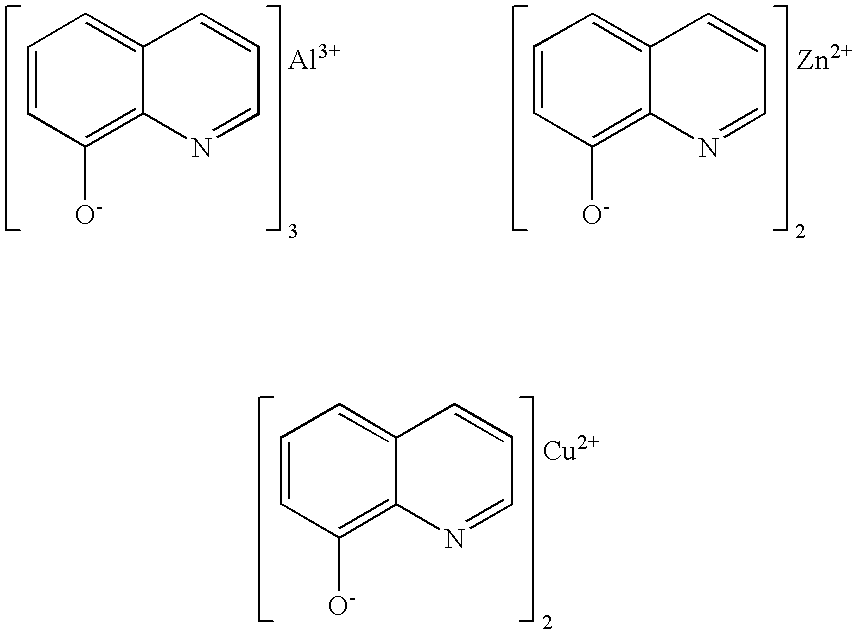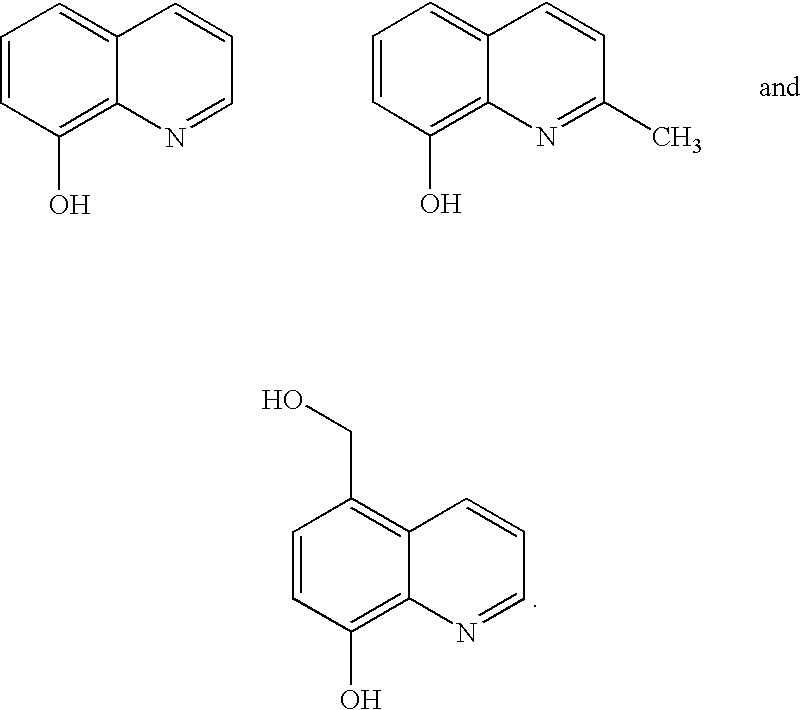Metal salts of quinolinols and quinolinol derivatives as adhesion and conductivity promoters in die attach adhesives
- Summary
- Abstract
- Description
- Claims
- Application Information
AI Technical Summary
Problems solved by technology
Method used
Image
Examples
example 1
Preparation of Bis-Quinolinol
[0040]
[0041] According to the procedure described by Donald. S. Noyce and Lloyd J. Dolby, Amino- and Chloromethylation of 8-Quinolinol. Mechanism of Preponderant ortho Substitution in Phenols under Mannich Conditions, in The Journal of Organic Chemistry, Volume 26, number 10, Oct. 24, 1961, at pages 4078 to 4083, bis-quinolinol was prepared via the reaction of 8-quinolinol and an excess of formaldehyde in an aqueous hydrochloric acid solution. 8-Quinolinol (29.0 grams, 0.2000 mol) and hydrochloric acid (37%, 85 mL) were combined in a four-neck, 250 mL, round bottom flask equipped with a magnetic stir bar, reflux condenser and hot oil bath. Initially, an exotherm of ˜25° C. was observed upon mixing these reagents. Formaldehyde (37%, 9 mL), was then added which resulted in a change from a clear yellow solution to a gold solution. The mixture was heated at reflux for 90 minutes. During this time heavy acidic fumes were generated. After mixing for 15 minute...
example 2
Preparation of Quinolinol / Piperidine
[0045]
[0046] Quinolinol can be volatile, and in this example, a quinolinol / piperidine derivative was prepared in order to increase the bulk and reduce the volatility of quinolinol. The asymmetry of this derivative promoted a lower melting point than that found for the bis-quinolinol. Quinolinol / piperidine was prepared in a melt by the reaction of equimolar amounts of 8-quinolinol, piperidine and paraformaldehyde.
[0047] 8-Quinolinol (29.0 grams, 0.2000 mol), piperidine (17.0 grams, 0.2000 mol) and paraformaldehyde (6.0 grams, 0.2000 mol) were charged to a 100 mL 3-neck round bottom flask equipped with a mechanical mixer, thermometer and reflux condenser. With mixing, the solids partially dissolved to an opaque gold liquid and the reaction temperature rose from room temperature to 71° C. within five minutes. Mixing was continued until the reaction temperature dropped to ˜60° C. At this point, the flask was placed in a hot oil bath preheated to 100...
example 3
Preparation of Hydroxy-Functionalized Quinolinol
[0049]
[0050] An hydroxy functionalized quinolinol intermediate was prepared via the reaction of equimolar amounts of 8-quinolinol and formaldehyde in an aqueous hydrochloric acid solution. (Note that quinolinol was synthesized similarly but with a molar excess of formaldehyde relative to 8-quinolinol). The product of this reaction showed improved solubility over bis-quinolinol and was more easily characterized. The synthesis procedure was obtained from Donald. S. Noyce and Lloyd J. Dolby, Amino- and Chloromethylation of 8-Quinolinol. Mechanism of Preponderant ortho Substitution in Phenols under Mannich Conditions, in The Journal of Organic Chemistry, Volume 26, number 10, Oct. 24, 1961, at pages 4078 to 4083.
[0051] 8-Quinolinol (120.0 grams, 0.8267 mol), hydrochloric acid (37%, 352 mL) and formaldehyde (37%, 67.7 grams), were combined in a four-neck one liter round bottom flask equipped with a magnetic stir bar, thermometer, reflux c...
PUM
| Property | Measurement | Unit |
|---|---|---|
| weight % | aaaaa | aaaaa |
| weight % | aaaaa | aaaaa |
| sizes | aaaaa | aaaaa |
Abstract
Description
Claims
Application Information
 Login to View More
Login to View More - R&D
- Intellectual Property
- Life Sciences
- Materials
- Tech Scout
- Unparalleled Data Quality
- Higher Quality Content
- 60% Fewer Hallucinations
Browse by: Latest US Patents, China's latest patents, Technical Efficacy Thesaurus, Application Domain, Technology Topic, Popular Technical Reports.
© 2025 PatSnap. All rights reserved.Legal|Privacy policy|Modern Slavery Act Transparency Statement|Sitemap|About US| Contact US: help@patsnap.com



